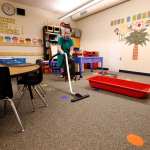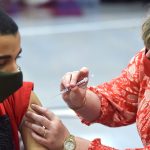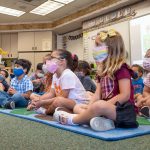We’re the only newsroom dedicated to writing about gender, politics and policy. Subscribe to our newsletter today.
New data suggests that President Joe Biden’s promise to reopen schools during his first 100 days in office could increase the spread of coronavirus, especially if schools do not take substantial disease prevention efforts while COVID-19 case counts remain high.
Currently, the Centers for Disease Control and Prevention does not recommend full in-person learning for school districts where more than 100 new cases per 100,000 people have emerged in the past seven days, or where test positivity rate is higher than 10 percent. And whether schools are able to use hybrid models or can resume fully in-person learning, the CDC advises that districts implement strict public health protocols to minimize the virus’ spread.
But in practice, that may be difficult to achieve, the new data suggests. The study, published Monday by the CDC, tracks COVID-19 cases in Cobb County, Georgia, between December 1 and January 24. The time-period included 24 in-person school days, during which about 2,600 elementary school students and 800 educators physically attended school. In that timeframe, the CDC found, COVID-19 cases increased almost 300 percent — going from a seven-day average of 157 cases per 100,000 people to 577 per 100,000.
In-person school — and in particular, transmission via educators — appear to have played a role in that surge. CDC researchers identified nine school-associated clusters of COVID-19 that emerged.
Researchers found that 13 educators and 32 students were involved in the clusters, or cases connected between one patient and two or more contacts. In at least four clusters, the educator appeared to be the “patient zero,” and all but one cluster involved educators likely transmitting the virus to students. In two clusters, educators appeared to transmit the virus to their adult colleagues — likely, the CDC found, in in-person meetings or at lunch — and those other educators may have spread the virus to students.
Those findings have significant implications for the nation’s children — teachers and early data say it’s clear that virtual learning has been less effective than in-person school — and also for the women who have borne the burden of executing pandemic education. Mothers in particular have dropped out of the workforce to supervise their kids’ learning full-time.
And teachers, who are mostly women, have been tasked with navigating remote and hybrid schooling, which many say is unpredictable and draining from a mental health standpoint. The findings about the role of teachers in the spread will grow even more salient if new, more infectious variants of the coronavirus take hold.
The data is consistent with other global research, which shows that adult transmission of coronavirus is the largest concern with opening elementary schools. They also illustrate the challenges of following the disease prevention measures, particularly physical distancing and indoor masking, that would make it safer to reopen schools.
For instance, though the schools observed erected plastic dividers between students’ desks, the large number of in-person school attendees meant students were still seated less than 3 feet apart, rather than the 6 feet recommended in communities with high community transmission of COVID-19. In seven out of the nine disease clusters, proximity between educators and students was likely a source of viral transmission, the researchers found.
And though schools reported high compliance with mask-wearing protocols — masks were only allowed off during lunch — inadequate mask-use emerged as a likely contributing factor in five of the disease clusters.
“To ensure safer in-person learning during the COVID-19 pandemic, schools should implement multicomponent mitigation strategies, including efforts to prevent infection among educators, and promoting consistent, correct mask use and physical distancing wherever possible, especially during mealtime when masks are not being worn,” the researchers wrote.
The researchers note that it was difficult to fully tease out how many Cobb County cases were acquired via school settings, since the study also took place at a time when community incidence of COVID-19 was steadily increasing. They also were not able to contact and test everyone who had been exposed to someone infected with COVID-19.
The recent decline in COVID-19 cases has sparked hope that more schools will be able to adopt in-person learning modules — either hybrid models that mix in-person and online learning (a strategy to keep class sizes down), or full in-person schooling. Currently, the United States has a seven-day average of just over 66,300 new cases per day, and an average of about 1,900 deaths per day.
As of last week, a quarter of counties had seen viral transmission decrease to a point that full in-person learning could resume, CDC Director Rochelle Walensky said at the time.
But new variants of the virus — including the B.117 version, which has begun to spread in the United States, and could become the dominant strain in March — could upend those hopes. If case counts continue to soar, the CDC may revisit its guidelines, Walensky said earlier this month.
“If we get to a point where we are beyond the red zone — really high levels of community spread related to these variants or related to more transmission — we may need to visit this again,” Walensky said on February. 12.







